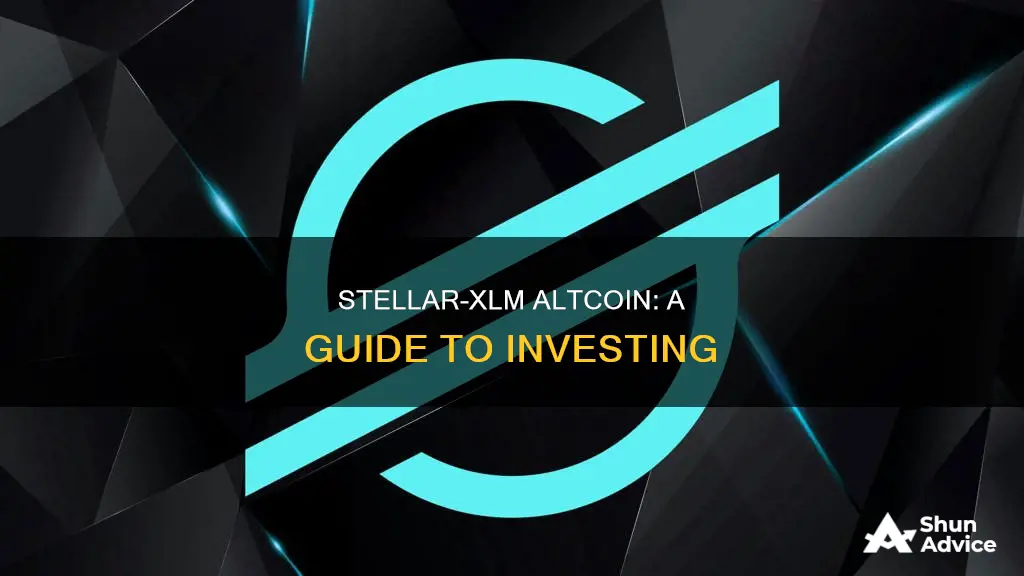
Stellar (XLM) is a peer-to-peer decentralised network created in 2014 by The Stellar Development Foundation or Stellar.org. The network officially launched in 2015 with the purpose of connecting the world's financial systems and ensuring a protocol for payment providers and financial institutions. The platform is designed to move financial resources swiftly and reliably at minimal cost. The cryptocurrency of Stellar is Lumens (XLM), which is used across the organisation's decentralised network.
| Characteristics | Values |
|---|---|
| Founder | Jed McCaleb and Joyce Kim |
| Year of Creation | 2014 |
| Purpose | To connect the world's financial systems and ensure a protocol for payment providers and financial institutions |
| Target Audience | Inhabitants of developing countries |
| Native Digital Currency | XLM or Lumens |
| XLM Use Case | Intermediate currency for operations and payment of transaction fees |
| XLM Price | $0.093368 USD |
| XLM Market Cap Ranking | #30 |
| Where to Buy XLM | Binance, Bybit, BTCC, BYDFi, Coinbase, Kraken, Uphold, Gemini, eToro, CEX.IO |
What You'll Learn

XLM's performance and potential as an investment
XLM has shown promise since its inception, with its value rising from a small fraction of a cent to $0.1087 as of 28 September 2022. However, this has not been without significant volatility, with wild swings before and after periods of relative stability. For example, between November 2020 and May 2021, XLM climbed from less than $0.09 to $0.73 before trending downward.
XLM's 59% drop since the beginning of 2022 is alarming, but when viewed in the context of the larger cryptocurrency market, it is in line with the performance of other major coins such as Bitcoin and Ethereum. This suggests that, despite the risks, XLM could be a viable long-term investment.
One factor that may cast doubt on XLM's investment potential is the fact that Stellar has destroyed half of its lumens and does not plan to create more. However, this also means that the coin will be scarce in the future, increasing its value over time. The potential for increased value makes XLM an attractive asset to buy and hold.
The value of XLM is closely tied to its utility. Lumens check both boxes because of Stellar's ability to process international payments quickly, efficiently, and at a low cost. Stellar also has the backing of some major players, including MoneyGram, IBM, and Stripe.
Stellar has experienced several growth spurts, such as when Mercado Bitcoin announced its use of the platform, leading to almost 3 million user accounts in less than a year. Since then, Stellar has signed on over 55,000 accounts of its own and built a network of partners that includes Coinbase, Franklin Templeton, and MoneyGram.
Stellar's unique features, such as its low transaction costs, fast transaction speed, and ability to facilitate cross-currency transactions, make it a compelling investment opportunity.
Bitcoin Investors: Arrested for Their Crypto Investments?
You may want to see also

How to buy XLM
XLM, or Stellar, is a cryptocurrency that can be purchased in a few different ways. Here is a step-by-step guide on how to buy XLM:
Step 1: Get a Stellar Wallet
Before purchasing XLM, you will need a wallet that supports this cryptocurrency. There are several options available, including hardware wallets such as Ledger Nano S and Ledger Nano X, or software wallets such as Blockchain.com's wallet. These wallets allow you to store your XLM securely and manage your transactions.
Step 2: Get your XLM Address
Once you have set up your Stellar wallet, you will need to obtain your XLM address. This address is a long string of uppercase characters that start with a "G". For example: GBPKZNCATMXQZZ622GZ57732XEVJCB7DDFLTJP2FXFOTJROELFNQIVSC. You will need this address when purchasing XLM to send the coins to your wallet.
Step 3: Choose a Payment Method
There are several ways to purchase XLM, depending on your preferred payment method. You can use a credit or debit card, bank transfer, or third-party payment platforms such as Google Pay or Apple Pay. Some popular platforms that support these payment methods include Binance, Coinbase, Uphold, and MoonPay.
Step 4: Purchase XLM
After setting up your wallet and choosing your payment method, you can proceed to purchase XLM. The process will vary depending on the platform you choose. For example, on Binance, you can navigate to the "Buy Crypto" link, select Stellar, choose your payment method, and confirm the order. On Coinbase, you can use the Coinbase app to select Stellar Lumens from the list of assets, enter the amount you want to buy, and finalize your purchase.
Step 5: Store or Trade your XLM
Once you have purchased XLM, you can choose to store it in your wallet or trade it for other assets. Some platforms, such as Uphold, allow you to store your XLM in their secure wallet or trade it for other cryptocurrencies, stablecoins, or metals. You can also consider staking your XLM on the Stellar network to earn passive income.
It is important to note that when purchasing XLM or any other cryptocurrency, you should do your own research and understand the risks involved. The value of cryptocurrencies can be highly volatile, and it is important to make informed investment decisions.
Fidelity's Bitcoin Investment: Exploring the Crypto Opportunity
You may want to see also

How Stellar differs from Ripple
How to Invest in Stellar (XLM)
Stellar (XLM) is a peer-to-peer decentralised network created in 2014 by the Stellar Development Foundation (SDF) to connect the world's financial systems. The platform is designed to transfer financial resources quickly, reliably, and at a low cost.
Where to Buy Stellar (XLM)
- Coinbase: This is a popular choice as it offers easy access to some of the most popular currencies.
- Binance
- Kraken
- Uphold
- Bitfinex
- Huobi
- Bittrex
- Kraken
Stellar and Ripple are often compared due to their shared founder, Jed McCaleb, and the similarities in their blockchains. However, there are some key differences between the two.
Target Market:
While Ripple is focused on banks and other financial institutions, Stellar is aimed at individuals, particularly those in developing countries who do not have access to banks.
Philosophy:
Ripple was created to address the challenges of cross-border payments, such as high costs and long processing times. In contrast, Stellar aims to provide fast and cheap international money transfers for everyday people, especially the unbanked or underbanked population.
Non-Profit Status:
The Stellar Development Foundation is a non-profit organisation, whereas Ripple is a for-profit company.
Coin Supply and Inflation:
Ripple has set a maximum supply of 100 billion XRP coins, while Stellar has set an unlimited supply for Lumens (XLM). Additionally, Ripple's supply will decrease over time as a small amount of XRP is burned with each transaction. On the other hand, Stellar has a fixed 1% inflation rate per year, with all transaction fees recycled.
Consensus Mechanism:
Ripple uses proof-of-correctness (POC) as its consensus mechanism, which is based on majority validation. In contrast, Stellar employs the Stellar Consensus Protocol (SCP), utilising Federated Byzantine Agreement consensus.
Centralisation:
Ripple is more centralised than Stellar, as evidenced by its ability to freeze Jed McCaleb's XRP coins after his departure from the company. This level of control contrasts with the concept of decentralisation.
Partnerships:
Ripple has established partnerships with numerous financial institutions, including Western Union, Accenture, American Express, MoneyGram, and SBI Group. On the other hand, Stellar has formed notable partnerships with tech giant IBM and carbon credit market Veridium.
Market Capitalisation:
As of writing, XRP has a market cap of over $13 billion, while XLM lags behind with a total of just over $2 billion.
In summary, while both Stellar and Ripple share similarities in their technology and founding team, they differ significantly in their target market, philosophy, coin supply, consensus mechanism, centralisation, partnerships, and market capitalisation.
Mutual Funds: Should They Invest in Bitcoin?
You may want to see also

The pros and cons of Stellar
Stellar is a multi-currency backend payment network that runs on tokens known as Lumens (XLM). It is a blockchain protocol that enables fast and cheap transactions.
Pros
- Stellar has fast transaction speeds, with most transactions taking under five seconds to complete.
- It supports multiple currencies on its network, including EUR, USD, and GBP.
- Transactions on the Stellar network are extremely cheap, with an average cost of a fraction of a Lumen, or a millionth of a cent.
- It is a truly decentralized network, run by peers and not owned by anyone.
- It has a high transactions per second capacity, estimated to be around 1,000.
- It has a strong development team, with a development FCAS score above 900, indicating an engaged and skilled developer community.
- It is one of the top 100 cryptocurrencies in the industry.
- It has a built-in exchange, allowing for efficient liquidity with the assets on the network.
- It has smart contracts and supports ICOs.
- It enables multi-signatures.
- It has a strong partnership with IBM, which has signed six banks to issue stablecoins based on XLM.
- It has a strong social mission: to provide financial services to the unbanked.
Cons
- The main disadvantage of Stellar is that it relies on stablecoin pairings to facilitate its traditional currency support for assets like the USD. This means that users must trust the issuer of the stablecoin (e.g. TetherUSD or AnchorUSD) to hold an equivalent reserve.
- Another disadvantage is that users must hold a minimum balance of Lumens in their account, plus some more for each asset they hold, to use the network.
- There is a risk of volatility if too many Lumens are released at once.
- There are many competitors in the same field, such as Ethereum and Ripple.
- Some transactions can take between two to five seconds to complete.
Strategies for Choosing the Right Crypto Coin
You may want to see also

How to store XLM
When it comes to storing your XLM, there are several options to choose from, each with its own advantages and disadvantages. Here are some of the most popular methods:
Ledger Nano S (Hardware Wallet):
The Ledger Nano S is a hardware wallet that supports XLM storage. It's a highly secure option, especially if you have a significant amount of XLM to store. The wallet also supports various other crypto assets, making it versatile. However, it's not a free option, with a price tag of $79 as of June 2023.
Foxlet (Desktop Wallet):
Foxlet is an open-source desktop wallet designed specifically for storing XLM. It allows you to encrypt your XLM secret key and store it on your computer. Foxlet has a simple interface and doesn't require registration. However, it doesn't support other cryptocurrencies.
Interstellar (Multi-Wallet):
Interstellar is a unique wallet as it has built a Decentralized Exchange (DEX), allowing users to exchange various coins without a centralised entity. It is available across multiple devices and operating systems. Additionally, it offers ledger hardware support and multisig coordination.
Stargazer (Desktop & Mobile Wallet):
Stargazer stands out for its support for both desktop and mobile platforms. It's designed to be simple and streamlined, making it user-friendly even for newcomers. However, it has received mixed reviews on the Google Play Store, with some users reporting bugs.
Lobstr (Mobile Wallet):
Lobstr is a mobile wallet for iOS and Android devices. It's known for its user-friendly interface and features like a built-in XLM price converter, 2-factor authentication, and fingerprint support. However, mobile wallets generally offer lower security compared to hardware wallets.
Astral (Web-Based Wallet):
Astral is a web-based wallet that offers features like dividend payments via an inflation pool and the ability to generate multiple addresses. It supports XLM, MOBI, and SLT tokens. While web-based wallets are less secure than hardware wallets, Astral addresses this by making 2-factor authentication mandatory and encrypting all data.
Paper Wallet:
A paper wallet is a secure option that involves writing down your public and private keys on a piece of paper. This method keeps your private keys offline and safe from digital threats. However, it carries the risk of physical damage or theft.
When choosing a wallet, it's essential to consider factors such as security features, private key control, backup and restore options, development team support, customer support, and support for multiple currencies. Additionally, always ensure that your chosen wallet meets the minimum balance requirement of 1 XLM.
Russia's Bitcoin Investment: Exploring the Country's Crypto Interests
You may want to see also
Frequently asked questions
Stellar is a peer-to-peer decentralised network created in 2014 by The Stellar Development Foundation or Stellar.org. It officially launched in 2015 with the purpose of connecting the world's financial systems and ensuring a protocol for payment providers and financial institutions. The platform is designed to move financial resources swiftly and reliably at minimal cost.
Stellar Lumens (XLM) can be bought directly on Coinbase. You can also buy Stellar Lumens through eToro's Stellar trading platform, CEX.IO, or Coinbase.
Stellar was built with the average user in mind, particularly those in developing countries. The platform provides access to the global economy through simple, quick, and low-cost transactions. It is also a non-profit foundation.
Ripple was created so that banks could make transfers around the world in a matter of seconds for a very small price. It improved the efficiency of banks and financial systems. Stellar, on the other hand, was designed for the average person to use and for banks to use.







